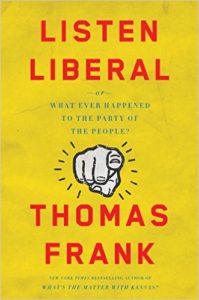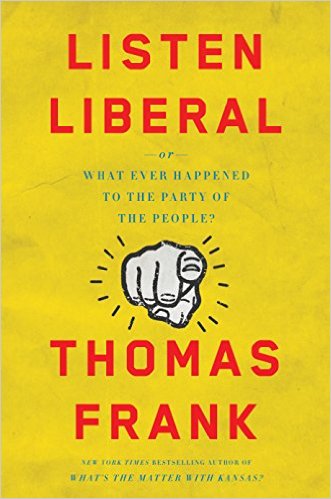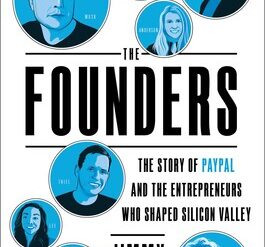
Blame for the widening gap between rich and poor and America is typically laid at the feet of the Republican Party, chiefly through the actions of Presidents Ronald Reagan and George W. Bush. Without question, these two men, and their right-wing collaborators in Congress, bear a lot of responsibility for the dire circumstances under which millions of Americans now eke out a living. But Thomas Frank, an historian and widely read liberal commentator, forcefully argues that many of the policies at the heart of today’s economic dysfunction were shaped under Democratic Presidents Bill Clinton and Barack Obama. Yes, this liberal icon finds fault with these two popular Democratic Presidents.
“It is time to face the obvious,” Frank writes, “that the direction the Democrats have chosen to follow for the last few decades has been a failure both for the nation and for their own partisan health.” He lays out the case in his eye-opening new book, Listen, Liberal: What Ever Happened to the Party of the People?
Listen, Liberal: Or, What Ever Happened to the Party of the People? by Thomas Frank ★★★★☆
The conservative roots of today’s liberal politics
Economic inequality in America today is all around us. The income of all except those at the very top of the pyramid has been stagnant for decades. A single family (the Waltons of Wal-Mart fame) possesses more wealth than 42% of American families combined. And 91% of all the economic gains over the past decade have gone to the “one percent.” The causes are reasonably easy to see. In contrast to the period from 1945 to 1980, when the country’s prosperity was broadly based and the middle class was the envy of the world, changes in labor, law enforcement, tax, social welfare, and trade policies have shifted the balance of power to the uppermost ranks of bankers, corporate executives, and the heirs to large fortunes.
Though he points to the growing rejection of New Deal values and policies within the Democratic Party of the 1970s, Frank traces the ideological rationale for many of these changes to the neoliberal Democratic Leadership Council (DLC). Founded in 1985, the DLC successfully moved the Democratic Party to the right, adopting traditionally Republican policies to broadcast its claim to the center of American politics. Among these were deregulation of finance and industry, “law and order,” deficit reduction, “entitlements reform,” lower taxes on the rich, and ending welfare — in other words, a shopping list of goals advanced by conservatives since the 1970s.
Liberal politics turned conservative under Bill Clinton
Bill Clinton, who served as DLC Chair in the year before he announced his candidacy for President, took steps toward all these objectives during the eight years of his Administration. He enacted laws toward these ends in partnership with Congressional Republicans: witness, for example, his expansion of the War on Drugs, NAFTA, “welfare reform,” and the repeal of Glass-Steagall (the signature banking reform of the New Deal). Less well known were his secret negotiations in 1997 with Newt Gingrich to privatize Social Security. As Frank points out, “the deal [with Gingrich] evaded Bill Clinton’s grasp, but only barely” — because the Monica Lewinsky affair blew up in his face.
What is the difference between Democrats and Republicans?
The groundswell of support for the candidacy of Senator Bernie Sanders this year dramatizes the conviction among many, especially young Americans, that there is no difference between Democrats and Republicans. While it’s true that both Bill Clinton and Barack Obama have staked out many positions that in other advanced countries might be considered conservative, the sad reality is that the Democratic Party is not alone in drifting to the right since the 1970s.
Today’s Republican Party advances policies that might have embarrassed Ronald Reagan — positions that can no longer be legitimately described as conservative. What the news media refer to as the Tea Party wing that dominates the Republican Party today represents a perspective that ignores reality and defies rational thought. Regrettably, then, even the most “moderate,” middle-of-the-road Democrat is a paragon of logic, common sense, and compassion by comparison. Unfortunately, Frank merely pays lip service to this all-important distinction.
An indictment of Bill Clinton and Barack Obama
In Listen, Liberal, Frank spells out the many ways in which Bill Clinton and Barack Obama have betrayed the Democratic commitment to progressive principles. The case against Clinton is solid, encompassing a litany of policies that still raise the hackles of activist Democrats, as enumerated above. His indictment of Obama, while difficult to contest on economic issues, is less convincing overall.
Frank acknowledges some of the progressive accomplishments of both men. “Clinton raised the minimum wage and expanded the Earned Income Tax Credit,” he writes. “He secured a modest tax increase on the wealthy.” And under his presidency the country achieved nearly full employment. But in Frank’s view these modest accomplishments paled against Clinton’s signature achievements, such as NAFTA, welfare reform, and the repeal of Glass Steagall. In the final analysis, Frank contends, “Clinton made the problems of working people materially worse. . . To judge by what he actually accomplished, Bill Clinton was not the lesser of two evils, as people on the left always say about Democrats at election time; he was the greater of the two. What he did as president was beyond the reach of even the most diabolical Republican.”
This liberal icon finds fault with liberal politics
Frank concedes the importance of Obama’s Affordable Care Act, but in his single-minded focus on economic inequality he dwells at length on the many ways that Obama continued to champion the same Wall Street-friendly economic and trade policies as Clinton. However, he largely ignores what the Obama Administration has sought to achieve in other areas, notably immigration policy and climate change. Frank would have been on solider ground had he limited his indictment to Clinton, whom historians are certain to regard as a conservative President. It would be difficult to render the same judgment about Obama without considerable qualification.
The root of the problem, as Frank sees it
For decades following the Great Depression, the Democratic Party’s success at the polls rested on what political historians have called the New Deal coalition, which found its greatest strength in trade unions, racial minorities, and white Southerners. This assemblage of forces began to unravel quickly with the passage of the Civil Rights Act of 1964, which drove many working class whites out of the Party, not just in the South but nationwide.
Beginning in the 1970s, Democratic intellectuals began to search for a new formulation that would reliably return a Democratic majority. Eventually, they found what they thought was the answer in the New Economy. Frank’s prose drips with sarcasm in describing this shaky concept: “Postindustrialism! Globalization! The information superhighway! These were gods before whom everyone bowed back then, deities who made their will known to the country’s opinion columnists and management theorists.” And the gods demanded that the Democratic Party turn its back on the unions, adopt free trade policies such as NAFTA, deregulate industry, lower taxes on the rich, and set its sights on Innovation and the so-called Creative Class.
Democrats identify with the “top 10%”
Instead of poor people and the working class, the Democratic Party came to identify itself with “the upper 10 percent of the population — the country’s financiers, managers, and professionals.” Frank refers to this diverse group as a “professional class” defined by graduate degrees and specialized white-collar work. At the apex of this class sit the exalted products of Harvard, Yale, Stanford, and other elite universities — the sort of people who have dominated both the Clinton and Obama Administrations. Supposedly, “[p]rofessionals are the people who know what ails us and who dispense valuable diagnoses.” In Frank’s view, they have proven to be the crux of the problem, not the solution.
About the author
Listen, Liberal is Thomas Frank‘s ninth book. He’s best known for What’s the Matter with Kansas: How Conservatives Won the Heart of America, a bestseller a decade ago. Frank is a columnist for Harper’s Magazine.
For more great reading
Like to read books about politics and current affairs? Check out Top 10 nonfiction books about politics.
If you enjoy reading nonfiction in general, you might also enjoy:
- Science explained in 10 excellent popular books
- Great biographies I’ve reviewed: my 10 favorites
- My 10 favorite books about business history
And you can always find my most popular reviews, and the most recent ones, on the Home Page.


























